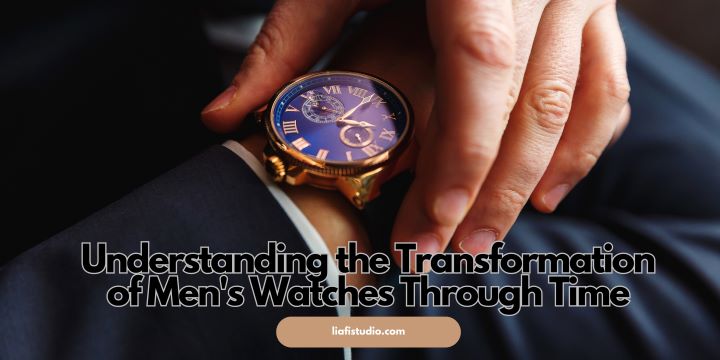Table of Contents:
- The Origins of Timekeeping
- The Wristwatch Revolution
- The Quartz Crisis and Its Aftermath
- Men’s Watches as Fashion Statements
- The Digital Era and Smart Watches
- Sustainable Timekeeping
- The Collector’s Passion
- Crafting Precision: The Art of Horology
- Navigating the Online Marketplace
- The Future of Men’s Watches
Key Takeaways:
- Insight into how men’s watches have progressed from functional gear to modern fashion accessories.
- Exploration of influential historical events that have shaped the design and perception of timepieces.
- Analysis of the role of technology and sustainability in the evolving watch market.
- Reflection on the significance of watch collecting as a hobby and investment.
Timepieces have been esteemed in men’s attire for centuries, intricately woven into society and personal identity. What once began as practical instruments have transitioned into sophisticated symbols that serve as extensions of individual styles. Fashionable yet cheap watches for men are more accessible now due to the vast online array, a clear indicator of the inherent value placed on watches despite the digital revolution. The intersection of tradition and technology has become the playground for the modern watch, reflecting our history and ambition.
The Origins of Timekeeping
The watch’s journey began in ancient civilizations, with devices like sundials or water clocks that depended on natural phenomena to mark time’s passage. However, when the first mechanical watch appeared in the 16th century, it revolutionized timekeeping by offering precision and portability. Fast-forward to the 17th century, the pocket watch emerged as a treasured possession, often elaborately decorated and treated as jewelry as much as a timekeeping tool.
The Wristwatch Revolution
The 20th century brought about the most substantial change in the history of watches. With World War I, wristwatches became a military necessity, facilitating synchronization during battle. Post-war, the practicality and heroism associated with wristwatches transitioned into civilian life. Innovations like water resistance, automatic movement, and shock resistance elevated their practicality and desirability. As watches moved onto the wrist, they became more visible and thus, gradually, a fashion statement.
The Quartz Crisis and Its Aftermath
With their inexpensive production costs and high accuracy, the arrival of quartz movement watches in the 1970s sent shockwaves through the traditional watchmaking industry. Many established brands faced near extinction. However, this dark period also sparked a renaissance of mechanical watchmaking, a resurgence based on appreciation for the intricate craftsmanship and the cachet of luxury timepieces. Collectors and enthusiasts began to covet the traditional mechanics that quartz watches lacked.
Men’s Watches as Fashion Statements
The 21st century has solidified watches as a cornerstone in men’s fashion. A diversity in designs, materials, and brands means that a watch can signify anything from athletic lifestyle to corporate prowess. Celebrities and style icons often sport unique timepieces that instantly become trendsetters. The importance of watches as fashion statements are underlined in comprehensive fashion pieces, like the watch guide for men by GQ, emphasizing their role as indispensable accessories.
The Digital Era and Smart Watches
With the dawn of the digital and information age, watches have transcended their original purpose. The entrance of smartwatches has melded the boundaries between technology and fashion, serving as mobile health monitors, communication devices, and more. Their functionality continues to expand, integrating with various aspects of daily life and pushing the boundaries of what a watch can do.
Sustainable Timekeeping
The watch industry is not immune to the global shift toward sustainability. With a consumer base more aware of their environmental impact, watchmakers are responding with innovations in sustainable materials and eco-friendly production practices. From solar-powered watches to those made from recycled materials, eco-conscious timekeeping is becoming a significant selling point for modern consumers seeking to align their purchases with their values.
The Collector’s Passion
Collecting timepieces is a hobby driven by an appreciation for their artistic and historical significance. The watch collector’s world is filled with quests for rare editions, historic models, and watches with unique stories. A timepiece can be much more than a tool for telling time; it can be a conversation piece, a memento, or a family heirloom passed down through generations. Collectors often see beyond the face value of a watch, considering its potential to appreciate over time and become a wise investment.
Crafting Precision: The Art of Horology
The meticulous art of horology, or watchmaking, remains admired in an era of mass production. The detailed process of assembling a watch by handstands is a testament to the unmatched skill of master watchmakers. Each watchmaker leaves a signature touch, a blend of artistic expression and engineering precision that commands respect and, often, a high price tag. This timeless dedication to craftsmanship is crucial in ensuring that traditional timepieces are revered in modern society.
Navigating the Online Marketplace
As the internet has made it easier to buy everything online, the world of men’s watches has expanded into the digital realm. However, with this convenience comes the challenge of navigating an oversaturated market. Enthusiasts and newcomers must discern between genuine articles and forgeries, assess quality, and ensure fair pricing. It becomes essential to be equipped with the knowledge to make informed decisions and recognize reputable vendors in an online marketplace with potential treasures.
The Future of Men’s Watches
The path ahead for men’s watches is both exciting and unpredictable. Technological advancements promise new functionalities and even entirely new categories of wearable devices. However, the allure of the traditional mechanical watch remains undiminished. As explored by Forbes in their article on trends shaping the future of watches, it’s clear that whether embracing the latest tech innovations or celebrating the craftsmanship of a bygone era, watches will continue to play a significant role in men’s fashion and culture.








